Abstract
To investigate the role of individual structural domains in viroid pathogenicity and replication, a series of interspecific chimeras was constructed by exchanging the terminal left (TL) and/or pathogenicity (P) domains between tomato apical stunt (TASVd) and citrus exocortis (CEVd) viroids. All six chimeras tested were replicated stably in tomato, and the symptoms exhibited by infected plants were intermediate between those induced by the parental viroids. Quantitative comparisons of symptom development and progeny accumulation revealed that: (i) the TL domain of TASVd contains a determinant required for appearance of severe veinal necrosis in tomato, (ii) the severe epinasty and stunting characteristic of TASVd requires the presence of its TL and P domains, and (iii) the variable (V) and terminal right (TR) domains comprising the right side of the native structure also play an important role in viroid pathogenicity. Chimeras containing the right side of TASVd accumulated to higher levels early in infection, and infected plants developed more severe symptoms than those whose right halves were derived from CEVd. Although the individual contributions of the TL and P domains to symptom induction could not be completely separated from that of viroid titer, the TL domain appears to exert a greater effect upon symptom severity than does the P domain. The TL, P, V, and TR domains of TASVd and CEVd contain three discrete regions of sequence and/or structural variability that may correspond to the pathogenicity determinants uncovered by our genetic analysis.
Full text
PDF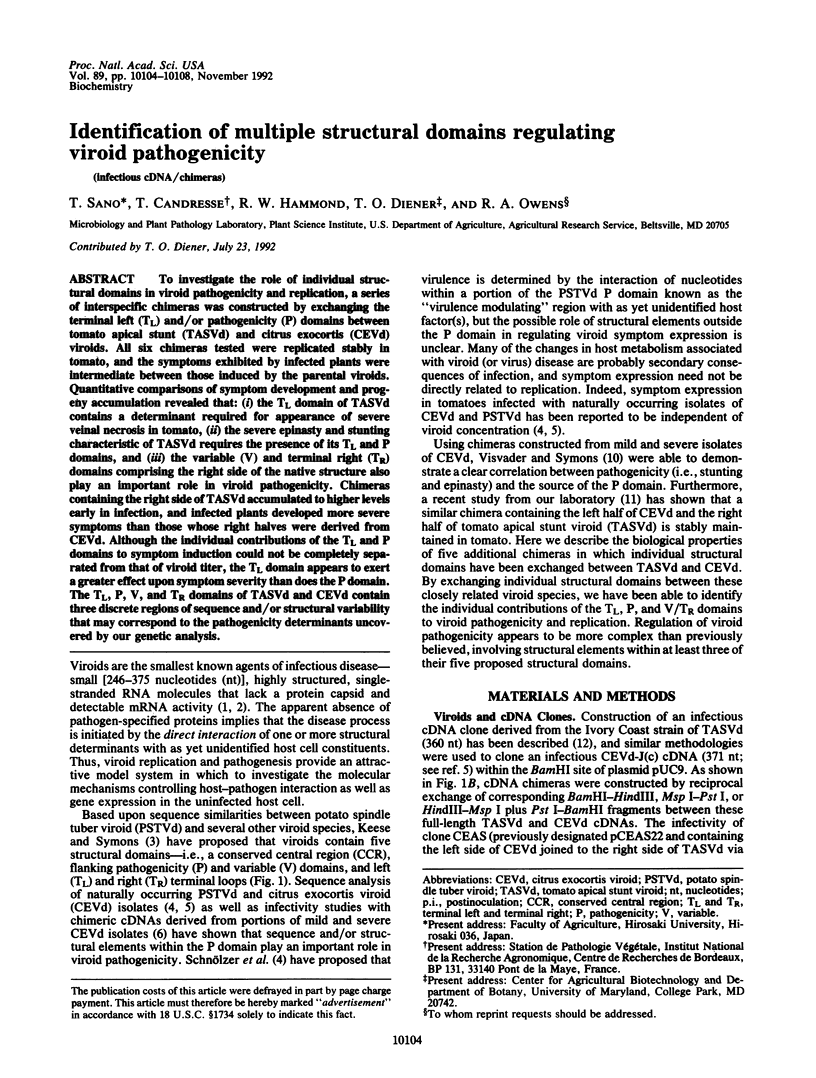
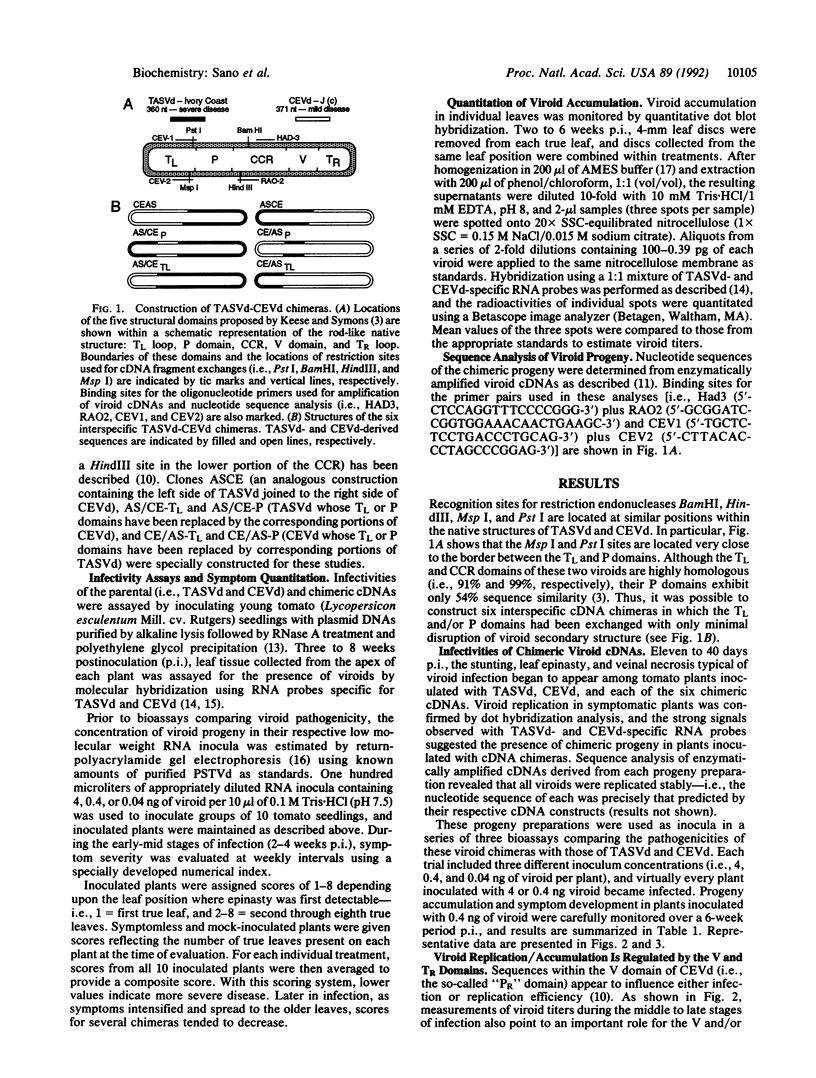
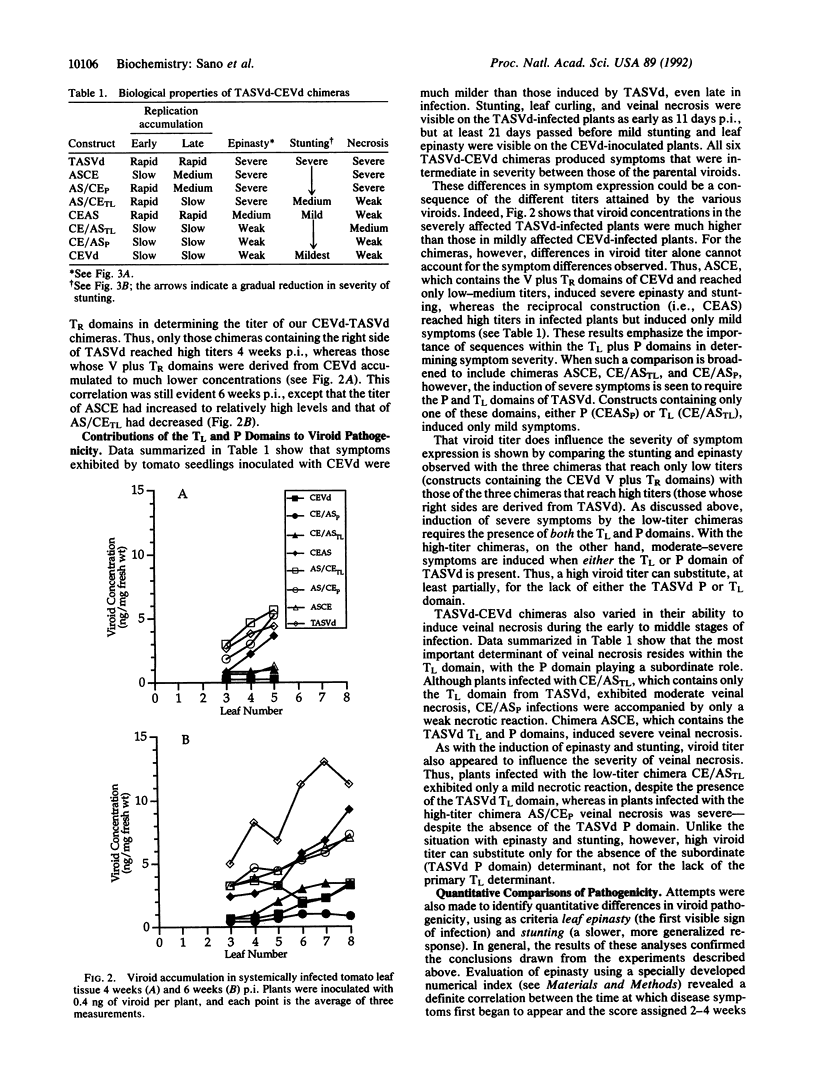
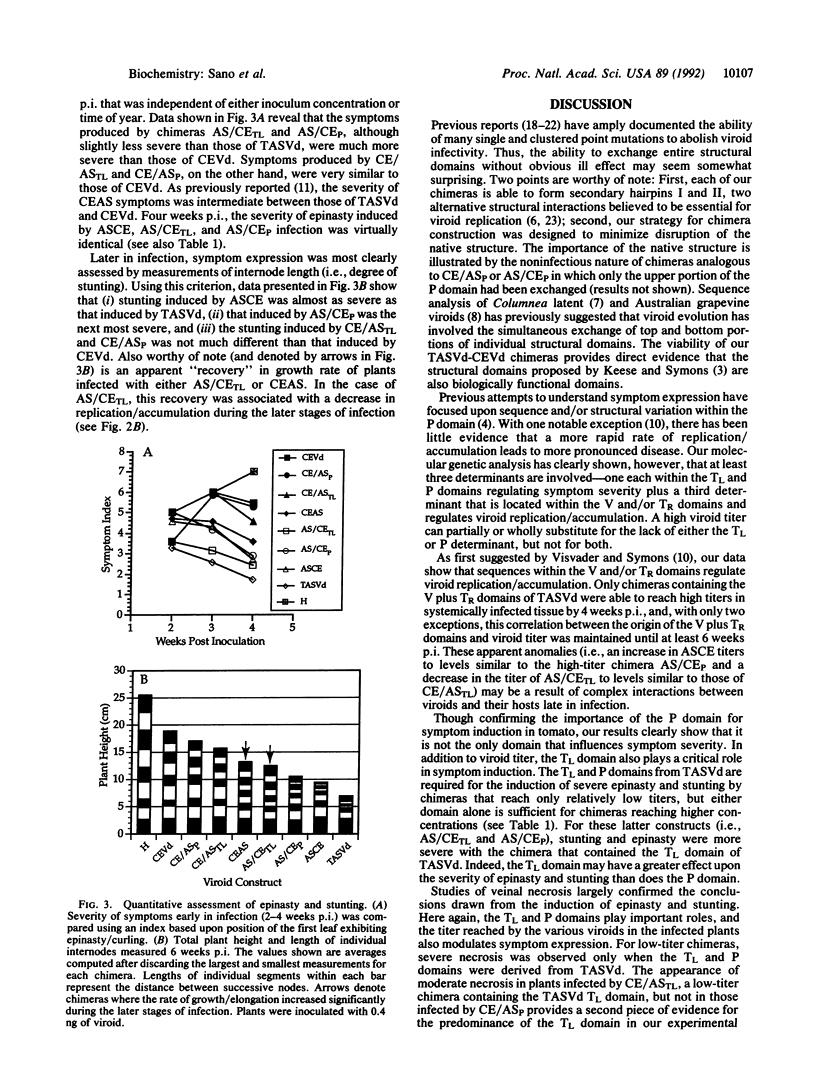
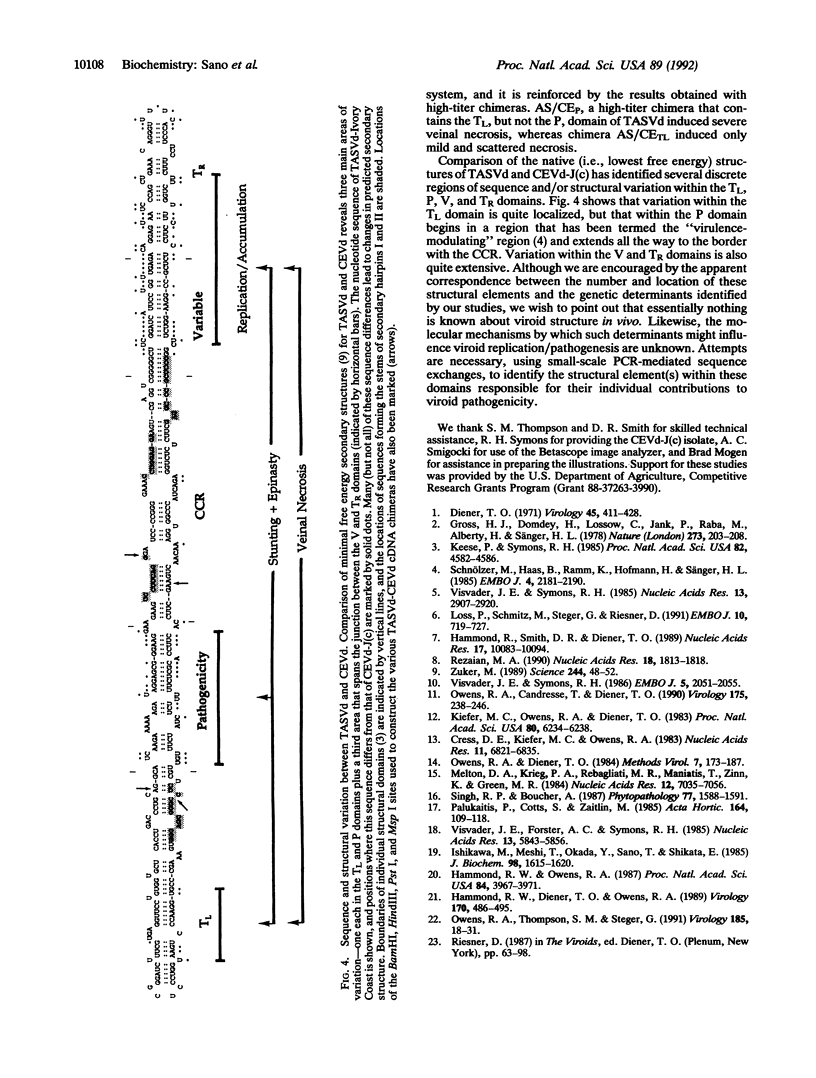
Selected References
These references are in PubMed. This may not be the complete list of references from this article.
- Cress D. E., Kiefer M. C., Owens R. A. Construction of infectious potato spindle tuber viroid cDNA clones. Nucleic Acids Res. 1983 Oct 11;11(19):6821–6835. doi: 10.1093/nar/11.19.6821. [DOI] [PMC free article] [PubMed] [Google Scholar]
- Gross H. J., Domdey H., Lossow C., Jank P., Raba M., Alberty H., Sänger H. L. Nucleotide sequence and secondary structure of potato spindle tuber viroid. Nature. 1978 May 18;273(5659):203–208. doi: 10.1038/273203a0. [DOI] [PubMed] [Google Scholar]
- Hammond R. W., Diener T. O., Owens R. A. Infectivity of chimeric viroid transcripts reveals the presence of alternative processing sites in potato spindle tuber viroid. Virology. 1989 Jun;170(2):486–495. doi: 10.1016/0042-6822(89)90440-6. [DOI] [PubMed] [Google Scholar]
- Hammond R. W., Owens R. A. Mutational analysis of potato spindle tuber viroid reveals complex relationships between structure and infectivity. Proc Natl Acad Sci U S A. 1987 Jun;84(12):3967–3971. doi: 10.1073/pnas.84.12.3967. [DOI] [PMC free article] [PubMed] [Google Scholar]
- Hammond R., Smith D. R., Diener T. O. Nucleotide sequence and proposed secondary structure of Columnea latent viroid: a natural mosaic of viroid sequences. Nucleic Acids Res. 1989 Dec 11;17(23):10083–10094. doi: 10.1093/nar/17.23.10083. [DOI] [PMC free article] [PubMed] [Google Scholar]
- Ishikawa M., Meshi T., Okada Y., Sano T., Shikata E. In vitro mutagenesis of infectious viroid cDNA clone. J Biochem. 1985 Dec;98(6):1615–1620. doi: 10.1093/oxfordjournals.jbchem.a135431. [DOI] [PubMed] [Google Scholar]
- Keese P., Symons R. H. Domains in viroids: evidence of intermolecular RNA rearrangements and their contribution to viroid evolution. Proc Natl Acad Sci U S A. 1985 Jul;82(14):4582–4586. doi: 10.1073/pnas.82.14.4582. [DOI] [PMC free article] [PubMed] [Google Scholar]
- Kiefer M. C., Owens R. A., Diener T. O. Structural similarities between viroids and transposable genetic elements. Proc Natl Acad Sci U S A. 1983 Oct;80(20):6234–6238. doi: 10.1073/pnas.80.20.6234. [DOI] [PMC free article] [PubMed] [Google Scholar]
- Loss P., Schmitz M., Steger G., Riesner D. Formation of a thermodynamically metastable structure containing hairpin II is critical for infectivity of potato spindle tuber viroid RNA. EMBO J. 1991 Mar;10(3):719–727. doi: 10.1002/j.1460-2075.1991.tb08002.x. [DOI] [PMC free article] [PubMed] [Google Scholar]
- Melton D. A., Krieg P. A., Rebagliati M. R., Maniatis T., Zinn K., Green M. R. Efficient in vitro synthesis of biologically active RNA and RNA hybridization probes from plasmids containing a bacteriophage SP6 promoter. Nucleic Acids Res. 1984 Sep 25;12(18):7035–7056. doi: 10.1093/nar/12.18.7035. [DOI] [PMC free article] [PubMed] [Google Scholar]
- Owens R. A., Candresse T., Diener T. O. Construction of novel viroid chimeras containing portions of tomato apical stunt and citrus exocortis viroids. Virology. 1990 Mar;175(1):238–246. doi: 10.1016/0042-6822(90)90204-5. [DOI] [PubMed] [Google Scholar]
- Owens R. A., Thompson S. M., Steger G. Effects of random mutagenesis upon potato spindle tuber viroid replication and symptom expression. Virology. 1991 Nov;185(1):18–31. doi: 10.1016/0042-6822(91)90749-2. [DOI] [PubMed] [Google Scholar]
- Rezaian M. A. Australian grapevine viroid--evidence for extensive recombination between viroids. Nucleic Acids Res. 1990 Apr 11;18(7):1813–1818. doi: 10.1093/nar/18.7.1813. [DOI] [PMC free article] [PubMed] [Google Scholar]
- Schnölzer M., Haas B., Raam K., Hofmann H., Sänger H. L. Correlation between structure and pathogenicity of potato spindle tuber viroid (PSTV). EMBO J. 1985 Sep;4(9):2181–2190. doi: 10.1002/j.1460-2075.1985.tb03913.x. [DOI] [PMC free article] [PubMed] [Google Scholar]
- Visvader J. E., Forster A. C., Symons R. H. Infectivity and in vitro mutagenesis of monomeric cDNA clones of citrus exocortis viroid indicates the site of processing of viroid precursors. Nucleic Acids Res. 1985 Aug 26;13(16):5843–5856. doi: 10.1093/nar/13.16.5843. [DOI] [PMC free article] [PubMed] [Google Scholar]
- Visvader J. E., Symons R. H. Eleven new sequence variants of citrus exocortis viroid and the correlation of sequence with pathogenicity. Nucleic Acids Res. 1985 Apr 25;13(8):2907–2920. doi: 10.1093/nar/13.8.2907. [DOI] [PMC free article] [PubMed] [Google Scholar]
- Zuker M. On finding all suboptimal foldings of an RNA molecule. Science. 1989 Apr 7;244(4900):48–52. doi: 10.1126/science.2468181. [DOI] [PubMed] [Google Scholar]


